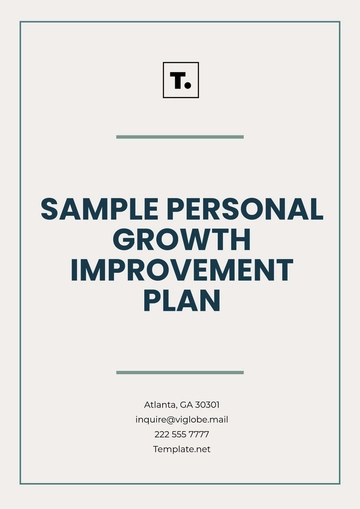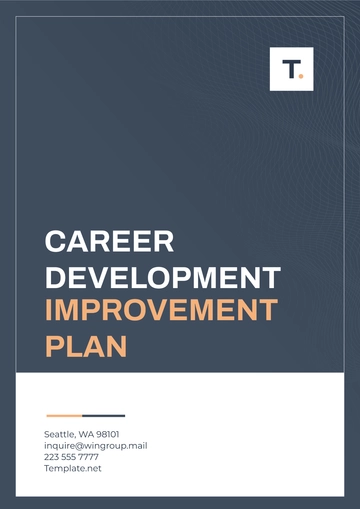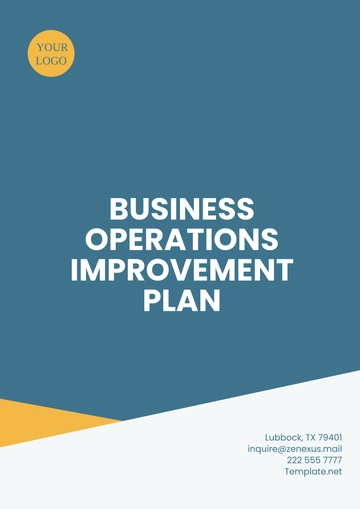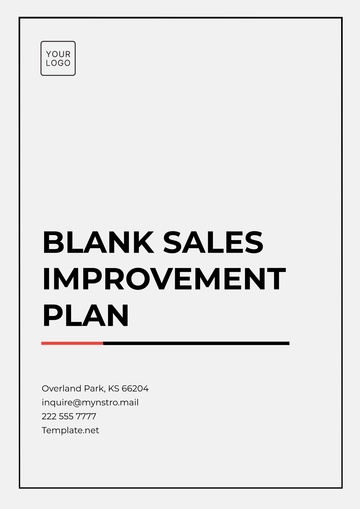Free Relationship Improvement Plan

Prepared by:
[YOUR NAME]
[YOUR COMPANY NAME]
1. Introduction
The Relationship Improvement Plan (RIP) is designed to enhance the professional dynamics between team members, fostering a collaborative, respectful, and productive work environment. The plan outlines a series of targeted strategies aimed at strengthening communication, trust, cooperation, and conflict resolution within the team. By addressing the foundational aspects of effective teamwork, this plan seeks to ensure sustainable improvements in workplace relationships and overall performance.
2. Objectives
Improve Communication: Enhance clarity and transparency in communication, ensuring that all team members understand each other’s expectations and feedback.
Build Trust: Foster a sense of mutual respect and dependability, encouraging openness and reliability among team members.
Enhance Collaboration: Strengthen teamwork through efficient collaboration tools and practices that promote collective success.
Resolve Conflicts Constructively: Equip the team with the skills to address conflicts proactively and diplomatically, fostering a positive and solution-focused atmosphere.
3. Strategies for Relationship Improvement
3.1 Communication Enhancement
Effective communication is the backbone of any successful team. To improve communication, the following strategies will be implemented:
Regular Team Meetings: Hold bi-weekly check-ins to discuss progress, challenges, and goals, ensuring alignment across all team members.
Open Feedback Channels: Introduce a structured feedback system where team members can provide and receive constructive feedback in a respectful and supportive environment.
Clear Documentation: Ensure all decisions, expectations, and goals are documented and accessible to team members to avoid misunderstandings.
3.2 Trust-Building Activities
Trust is built through consistent actions, transparency, and respect. The following activities will support trust development:
Team-Building Exercises: Organize monthly team-building activities to improve rapport and cooperation, both inside and outside of the office setting.
Transparent Decision-Making: Establish a process for transparent decision-making where team members are involved in key decisions that impact their work.
Recognition and Appreciation: Regularly acknowledge individual and team achievements, fostering an environment where each member feels valued and respected.
3.3 Collaboration Tools and Techniques
To improve collaboration, leveraging technology and fostering a culture of collective problem-solving is essential:
Project Management Software: Implement tools like Trello or Asana to streamline task management, enhance tracking, and improve accountability.
Shared Calendars and Documents: Use Google Calendar and shared document platforms to coordinate schedules and access collaborative resources.
Brainstorming Sessions: Hold monthly creative sessions where team members can contribute ideas freely, fostering innovation and inclusivity.
3.4 Conflict Resolution Strategies
Effective conflict resolution is critical for maintaining a positive working environment:
Conflict Resolution Training: Offer quarterly workshops on conflict management, providing team members with practical skills to handle disagreements professionally.
Mediation Practices: Introduce a neutral mediator or HR representative who can help resolve conflicts fairly and constructively when necessary.
Clear Conflict Protocols: Establish a clear, agreed-upon process for reporting and resolving conflicts, ensuring that issues are addressed before escalating.
4. Implementation Timeline
Phase | Objective | Timeline | Key Actions |
|---|---|---|---|
Phase 1: Initial Assessment | Assess team dynamics and set goals. | Month 1 | Conduct surveys and set goals. |
Phase 2: Training & Deployment | Implement strategies. | Month 2 - Month 3 | Launch team-building, introduce tools, and conduct workshops. |
Phase 3: Review & Adjustments | Evaluate progress and adjust strategies. | Month 4 | Collect feedback and review outcomes. |
5. Monitoring and Evaluation
Ongoing monitoring is essential to track the success of the Relationship Improvement Plan:
Feedback Mechanisms: Use regular surveys and anonymous feedback tools to gather insights on team morale, communication effectiveness, and trust levels.
Performance Metrics: Measure improvements in team productivity, task completion rates, and project collaboration using project management tools.
Employee Satisfaction Surveys: Conduct quarterly surveys to gauge employee satisfaction with communication and team dynamics.
Progress Reviews: Hold monthly review sessions with the team to assess the impact of the plan and identify areas that require further attention.
6. Conclusion
The Relationship Improvement Plan is a proactive approach to cultivating stronger, more cohesive professional relationships within the team. By enhancing communication, rebuilding trust, leveraging collaboration tools, and effectively managing conflicts, this plan seeks to create a work environment where mutual respect and cooperation flourish. With clear objectives, actionable strategies, and regular monitoring, the plan ensures that progress is measurable and improvements are sustainable. Through the successful execution of this plan, the team will foster a more dynamic, productive, and supportive workplace.
- 100% Customizable, free editor
- Access 1 Million+ Templates, photo’s & graphics
- Download or share as a template
- Click and replace photos, graphics, text, backgrounds
- Resize, crop, AI write & more
- Access advanced editor
The Relationship Improvement Plan Template from Template.net is fully editable and customizable, designed to enhance and strengthen your relationships. Tailor the plan to suit your unique needs and goals. Editable in our AI Editor Tool, this template offers a personalized approach, helping you track progress and foster deeper, more meaningful connections.
You may also like
- Finance Plan
- Construction Plan
- Sales Plan
- Development Plan
- Career Plan
- Budget Plan
- HR Plan
- Education Plan
- Transition Plan
- Work Plan
- Training Plan
- Communication Plan
- Operation Plan
- Health And Safety Plan
- Strategy Plan
- Professional Development Plan
- Advertising Plan
- Risk Management Plan
- Restaurant Plan
- School Plan
- Nursing Home Patient Care Plan
- Nursing Care Plan
- Plan Event
- Startup Plan
- Social Media Plan
- Staffing Plan
- Annual Plan
- Content Plan
- Payment Plan
- Implementation Plan
- Hotel Plan
- Workout Plan
- Accounting Plan
- Campaign Plan
- Essay Plan
- 30 60 90 Day Plan
- Research Plan
- Recruitment Plan
- 90 Day Plan
- Quarterly Plan
- Emergency Plan
- 5 Year Plan
- Gym Plan
- Personal Plan
- IT and Software Plan
- Treatment Plan
- Real Estate Plan
- Law Firm Plan
- Healthcare Plan
- Improvement Plan
- Media Plan
- 5 Year Business Plan
- Learning Plan
- Marketing Campaign Plan
- Travel Agency Plan
- Cleaning Services Plan
- Interior Design Plan
- Performance Plan
- PR Plan
- Birth Plan
- Life Plan
- SEO Plan
- Disaster Recovery Plan
- Continuity Plan
- Launch Plan
- Legal Plan
- Behavior Plan
- Performance Improvement Plan
- Salon Plan
- Security Plan
- Security Management Plan
- Employee Development Plan
- Quality Plan
- Service Improvement Plan
- Growth Plan
- Incident Response Plan
- Basketball Plan
- Emergency Action Plan
- Product Launch Plan
- Spa Plan
- Employee Training Plan
- Data Analysis Plan
- Employee Action Plan
- Territory Plan
- Audit Plan
- Classroom Plan
- Activity Plan
- Parenting Plan
- Care Plan
- Project Execution Plan
- Exercise Plan
- Internship Plan
- Software Development Plan
- Continuous Improvement Plan
- Leave Plan
- 90 Day Sales Plan
- Advertising Agency Plan
- Employee Transition Plan
- Smart Action Plan
- Workplace Safety Plan
- Behavior Change Plan
- Contingency Plan
- Continuity of Operations Plan
- Health Plan
- Quality Control Plan
- Self Plan
- Sports Development Plan
- Change Management Plan
- Ecommerce Plan
- Personal Financial Plan
- Process Improvement Plan
- 30-60-90 Day Sales Plan
- Crisis Management Plan
- Engagement Plan
- Execution Plan
- Pandemic Plan
- Quality Assurance Plan
- Service Continuity Plan
- Agile Project Plan
- Fundraising Plan
- Job Transition Plan
- Asset Maintenance Plan
- Maintenance Plan
- Software Test Plan
- Staff Training and Development Plan
- 3 Year Plan
- Brand Activation Plan
- Release Plan
- Resource Plan
- Risk Mitigation Plan
- Teacher Plan
- 30 60 90 Day Plan for New Manager
- Food Safety Plan
- Food Truck Plan
- Hiring Plan
- Quality Management Plan
- Wellness Plan
- Behavior Intervention Plan
- Bonus Plan
- Investment Plan
- Maternity Leave Plan
- Pandemic Response Plan
- Succession Planning
- Coaching Plan
- Configuration Management Plan
- Remote Work Plan
- Self Care Plan
- Teaching Plan
- 100-Day Plan
- HACCP Plan
- Student Plan
- Sustainability Plan
- 30 60 90 Day Plan for Interview
- Access Plan
- Site Specific Safety Plan




























